Some time ago we published an article dedicated to the five Roman expeditions that entered sub-Saharan Africa, which did not mark a southern border because it would have required an effort that was not clear if it would be repayable, limiting their domain to the Mediterranean coast, but they did establish some of the farthest points from the metropolis. Although the Arabian peninsula is not part of that continent, it could also be added to those distant territories that Rome reached, since, following orders from Augustus, an army of the prefect of Egypt, Elio Gallo, arrived there, whose mission ended badly.
Gaius Octavio, adopted by his great-uncle Julius Caesar in 44 BC, succeeded him after getting rid of his main rivals, Marco Antonio and Gaius Emilio Lepidus, with whom he had initially formed the so-called Second Triumvirate to share power and avoid a war that in the end could not be avoided. It was the year 27 B.C. when the Senate granted Octavian the cognomen of Augustus the First and the title of princeps later, making him de facto emperor to the point that he adopted the official name of Imperator Caesar Divi Filius Augustus .
From then on, he concentrated all political powers in his person, although he granted some to the senators to maintain the republican fiction; but he did it with no one in opposition, which allowed her to focus his attention on solving the problems of his new empire. On a military level, the most pressing was to solve the resistance of the peoples of northern Hispania, Cantabria and Astures, who had remained irreducible for a quarter of a century before. It was the year 27 BC, when Augustus restructured the Iberian Peninsula into three provinces, Bética, Tarraconense and Lusitania, being framed in the latter Asturiae and Gallaecia.
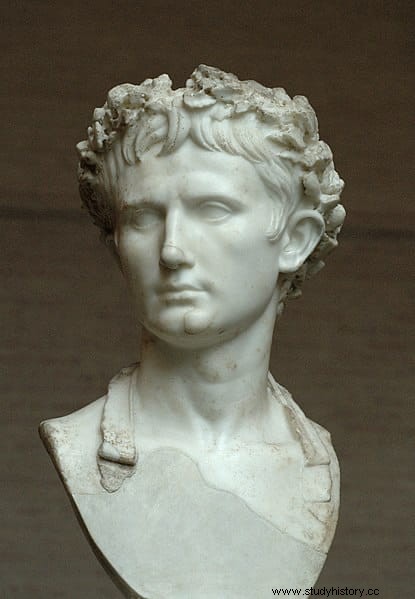
The following year he traveled personally and was immersed in that campaign -which would not end until 19 BC- when the rich booty he was obtaining at the expense of the local mines -especially the gold from Las Médulas- encouraged him to undertake other strategic conquests. , creating buffer territories against possible foreign incursions:in the Alpine region against the German danger and in Armenia against the Parthians. At the end of his reign, around the year 10 AD, he would even sponsor -or at least allow- the expedition that the King of Numidia, Juba II, an ally of Rome, sent to Mauretania Tingitana (Morocco), establishing a factory for the production of purple in Mogador (now Essaouira).
Mogador and Sala Colonia (also called Salé, current Chellah), served as a base to visit the Canary Islands, Madeira, São Tomé and Príncipe, Cape Verde and Fernando Poo around the year 10 AD. It has not been possible to determine whether these sailors were able to land on the Guinean coast, but the fact is that Roman coins have been found there - as in Togo, Ghana, Nigeria and Niger. It is true that they were able to arrive by commercial means, although the important thing is that the sights were already set at quite distant latitudes.
In this sense, the year 26 BC, the same year in which the Romans founded the Hispanic cities of Portus Victoriae Iuliobrigensium (which is not clear if it is the current Santander or Santoña) and Iulia Ilici Augusta (Elche), and the generals Cayo Antistio Veto and Publio Carisio led the war against the aforementioned Cantabrians and Asturians respectively, an Augustus who followed the operations more or less closely decided to undertake another military adventure and this time in a land as exotic as Arabia Felix, which some reader may remember for the article we dedicated to the Danish explorer Carsten Niebuhr.
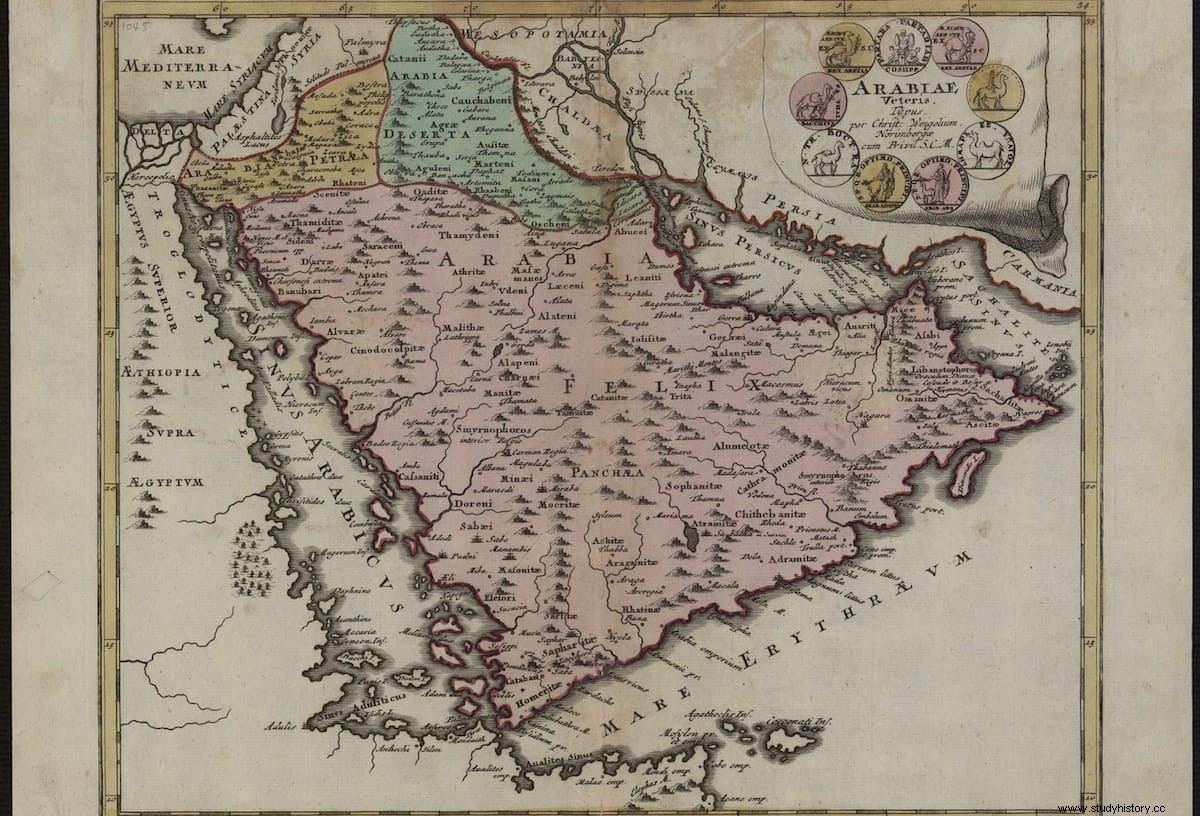
Arabia Felix was the name given in Ancient Rome to one of the three provinces into which the Arabian peninsula would be divided, the coastal one, the other two being Arabia Petrea (the ancient Nabataean kingdom, in present-day Jordan, southern Syria and Israel, Sinai and northwestern Saudi Arabia) and Arabia Deserta (the interior desert, evidently populated by nomadic tribes), after their conquest. But this would take place already at the beginning of the second century AD. For the time being, Arabia Felix, roughly corresponding to present-day Yemen and Oman, remained free from Roman power.
Of course, its possession was tempting because in ancient times the climate was a little different, less dry than now and, therefore, it was a region covered with fertile fields. However, the most appealing thing was that, by covering the coastlines of the Red Sea and the Eritrean Sea, they made it a key commercial hub for merchandise of aromatic spices and other products that arrived from India and the Horn of Africa:cinnamon, musk, incense, myrrh, gems, fabrics, cosmetics, pharmaceuticals….
According to Strabo, the territory was divided among five kingdoms, each specialized in one article, with the main port located on the Red Sea, in Eudaemon (today Aden), a Greek name that meant fertile or productive , although the Romans translated it as happy , in that sense. And precisely Strabo was a close friend of Elio Gallo, the man appointed by Augustus in 24 BC. to lead that expedition; in fact, the main source we have to know this is his work Geography , completed by the Roman history Cassius Dio and the Naturalis Historia by Pliny the Elder , plus some details of Jewish Antiquities of Flavius Josephus.
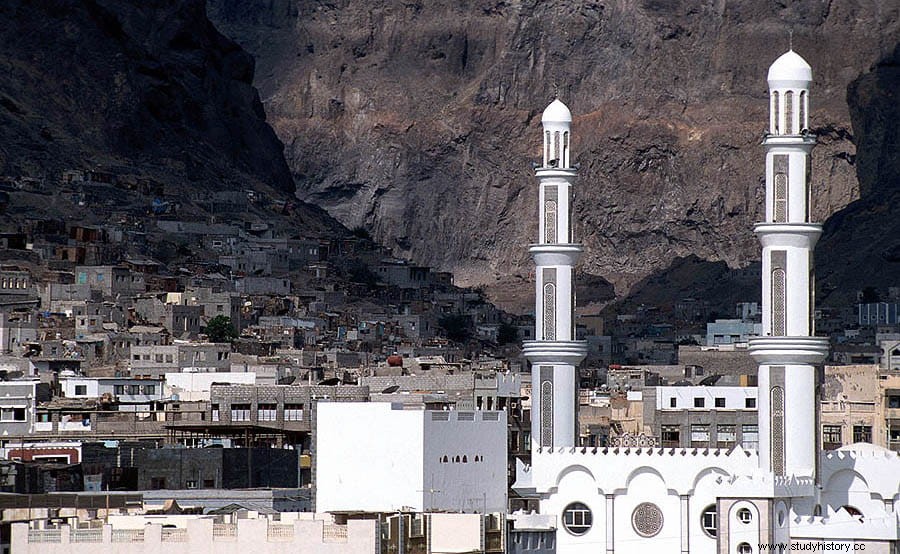
Incomplete narrations, in any case, since almost nothing is known about Gallus prior to that trip, except that he was perhaps the adoptive father of Sejanus, prefect of the Praetorian Guard and later the right-hand man of Tiberius) and that he belonged to the ordo quester (the equites, a social class intermediate between the senatorial and the plebeian) and that it was surely the same one that Galen often quotes, having taken note of the remedies that he used during his mission.
In 26 BC, Gaul was named praefectus Alexandreae et Aegypti (prefect of Alexandria and Egypt), a recently created position, similar to that of proconsul and attached directly to Augustus due to the economic importance of the country, famous "granary of Rome" (hence it also included Augustalis in the denomination), whose first owner was Gaius Cornelius Gallo. He got this one, just like the social promotion to eques , by his determined support of Octavian, whose fleet he commanded in Egypt. There he contained the last Ptolemies in Thebes and began a campaign of self-glorification -stelae, statues...- which was ultimately going to be counterproductive.
And it is that the Senate considered that he was planning a secession from Egypt, so they ordered him to be prosecuted for high treason and Cornelius Gallo ended up banished first and taking his own life later, that same year. Despite his friendship, the emperor did nothing to prevent it, perhaps also falling into suspicion or perhaps understanding that everything was due to a senatorial action to cut him military merits and power. Cornelius Gallus was succeeded by his namesake, who once in Egypt learned that his predecessor had opened trade relations with Ethiopia, a region that served as a bridge to the Arabian Peninsula due to its proximity.
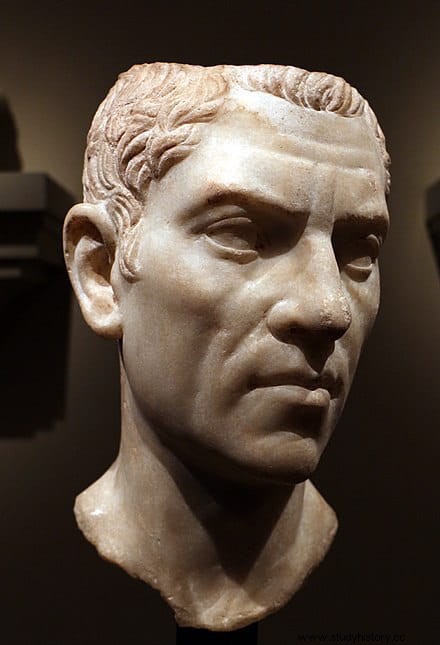
The news must also have reached Augustus, who, as we said before, in 24 B.C. he commissioned the new prefect to organize an expedition to Arabia Felix with the aim of signing friendship treaties with those buoyant kingdoms or, in case of refusal, conquering them. This would, on the one hand, keep the new prefect entertained, preventing ambitions like those of his predecessor from entering him; on the other hand, access to wealth that was supposed to be overflowing, reducing both the costs of long trips and the fees imposed by intermediaries between the region and the Mediterranean, by being able to sail directly to India through the Indian Ocean.
Among these intermediaries were the Sabeans, a Semitic people who on an unknown date crossed the peninsula and founded the Kingdom of Saba (present-day Yemen) around the 12th century BC, dedicating themselves to the trade in aromatic spices. Also the Himyarites, which the Greeks and Romans called Homerites, dedicated to agriculture and the traffic of myrrh and frankincense, and who a year after the episode we are telling here would invade Saba. And we must also mention the Lajmida kingdom, also known as Munadhirida, led by the tribe of the Banū Lajm (Sons of Lajm), who lived on the Iranian plateau, on the right bank of the Euphrates River, controlling the passage of spices to the Arabian peninsula by land.
Immediately, Elio Gallo got to work and ordered to concentrate a fleet of eighty biremes and triremes in Alexandria. The dimensions were disproportionate, if one takes into account that there was no actual state of war and the presumed potential enemies lacked naval force to oppose, so finally he replaced the warships with one hundred and thirty cargo ships in which he embarked the soldiers of the Legio XXII Deiotariana . Along with the Hebrew (five hundred) and Nabataean (one thousand) auxiliaries respectively sent by King Herod I the Great and Obodas III, numbered about ten thousand men.
The aforementioned legion, created in the time of Gaius Marius, in the year 48 BC, owed its name to Deyotaro, king of the Tolistobogians, a Galatian -Celtic- tribe from Galatia (current Turkey), who allied with Pompey against Mithridates VI in the so-called Third Mithridatic War to later accompany Julius Caesar in his campaign through Pontus. It was made up of Galatian legionnaires, but trained and led by Roman officers, joining the imperial army and assigned to Nicopolis (a town near Alexandria) together with the Legio III Cyrenaica .
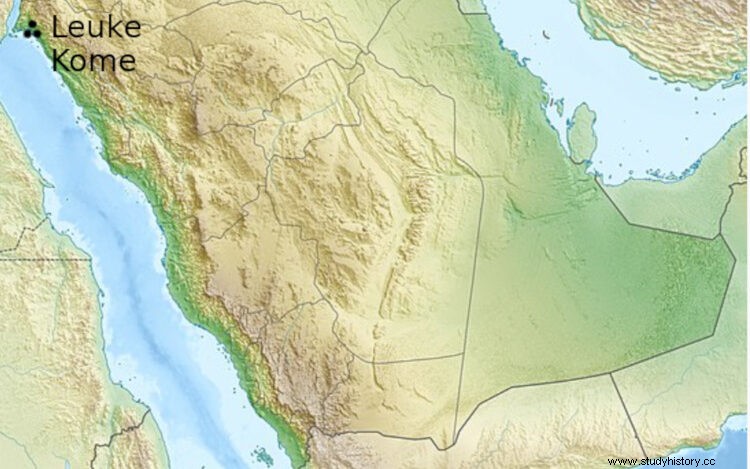
The troops made the crossing -incomprehensibly long, fourteen days- and landed in Leuke Kome, the southernmost village of the Nabataean kingdom, devoid of defenses and of indeterminate location, although Plutarch, in the episode dedicated to Marco Antonio of his Parallel lives , places it between the ports of Beirut and Sidon (today it is believed to coincide with Wadi Ainounah, in the Gulf of Aqaba). There the first setback occurred:Galo was immobilized all winter due to the weakening that the continuous illnesses caused to the soldiers, which were added to those resulting from the shipwreck of some boats.
Luckily, he was welcomed by the king of the Zamudíes, an Arab tribe from the north of the peninsula that provided troops to cover the decimated Roman ranks (later, he tells Notitia dignitatum , a document from the 5th century AD. detailing the Roman administrative organization, the Zamudis would be integrated into the cavalry of the imperial army). The thousand Nabataean warriors sent by Obodas III had come under the command of his minister Sileo, who as a connoisseur of the area should act as a guide. However, the monarch did not trust the Romans and instructed his subordinate to delay their advance as long as possible. Sileo not only did so but then led Gallus along the worst road to Aretas (perhaps Medina), a kingdom that bore the name of his sovereign, a relative of Obodas, which took a month to reach.
They then continued across the desert to Ararene, in the Sabaean kingdom, which made food and water supplies scarce, exhausting the troops again and causing them to continue to dwindle; by diseases and sunstroke, since the natives were not especially bellicose or skillful in war. Sileo avoided stopping at the largest oases, such as Yathrib-Medina or Dedam, and barely managed to reach Negrana (perhaps Najran, in the southwest of present-day Saudi Arabia), which half a millennium later would be the largest transpeninsular caravan hub. important, linking Mecca with Gaza through Medina.
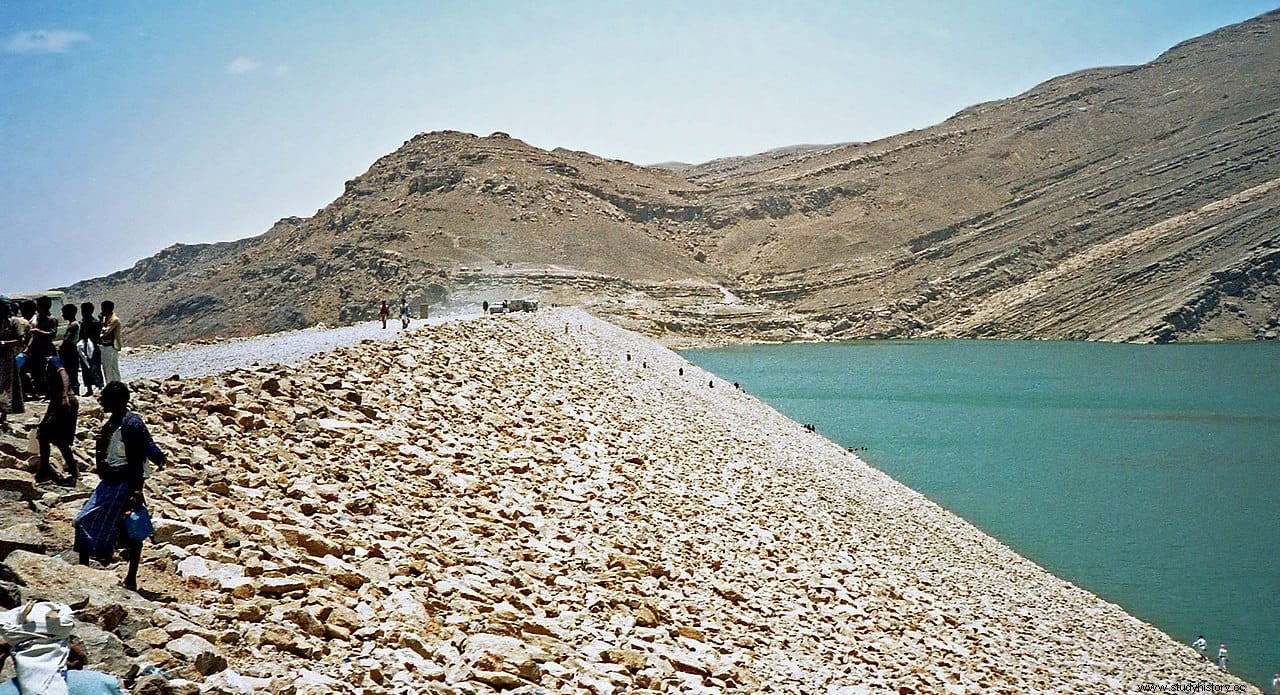
Gallus took possession of the place, as he did later with Nasca (in present-day Oman) and Athrula (a town that has not been identified), arriving at what Strabo calls the kingdom of the Rhamanites, whom Pliny supposed descendants of Radamantis, son that Zeus had with Europe and brother of the legendary King Minos of Crete. Later he managed to present himself before the walls of Marsiaba (or Marsibia or Mariaba, the now Yemeni Marib, hometown of the famous queen of Sheba), which he laid siege to. The siege lasted no more than six days because the epidemics hit the Romans, so the prefect had to make do with the surroundings, which were very fertile and prosperous thanks to the irrigation provided by a large dam that we discussed in another article.
At the same time, and as a desperate measure, Galo sent a messenger to the coast ordering his fleet to take Eudaemon. However, and despite the fact that the objective was not more than a couple of days away, the prefect gave up going there with his infantry, assuming that the expedition had failed -although it is rare, considering his superiority on the battlefield. , so it is possible that their presence in Egypt was claimed- and the only thing left was to return before they all fell ill and died or the enemies took advantage of their prostration to unite against them.
If the outward journey had lasted for six interminable and painful months, the return journey only took about sixty days, perhaps because Gallus realized Sileo's betrayal - arrested and sent to Rome - and took another route passing through Hepta Phreata, Chaalla, Malotha and another unidentified place, Egra, as well as Mios Hormos, a port on the Red Sea built by the Ptolemies in the 3rd century BC. and that it was also an important commercial center with India, as Strabo wrote (by the way, confusing Elio Gallo with his predecessor):
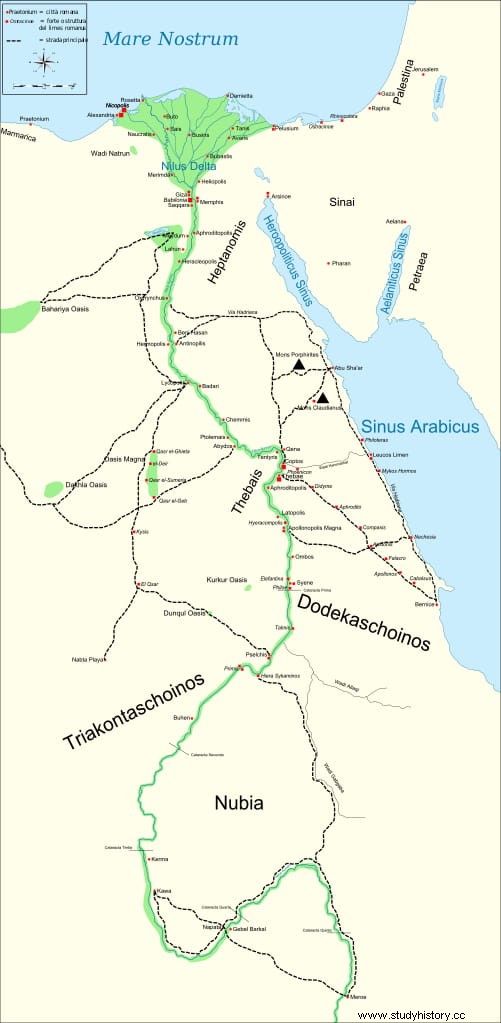
At last, past the Red Sea and down the Nile to the delta, that hapless expedition reached Alexandria, exhausted and unsuccessful, to find a not much better prospect in Nubia. The kandake Amanirena, queen of the Kushites whom Strabo calls Candace and who seems to have had one eye, had taken advantage of that half year of absence to shake off the vassalage to Rome, attacking Aswan and Philé, expelling the Jews from Elephantine and taking a good booty . Amanirena even ordered the head of a bronze statue of Augustus to be buried at the door of her palace so that everyone could step on it when entering and leaving it, in an unequivocal and symbolic gesture of insubordination.
The Legio III Deiotariana , who actually only suffered seven casualties in combat, had to postpone his long-awaited rest to face them, but he was not able to prevail and the emperor dismissed Aelius Gallus that same 25 BC, appointing his friend Publius Petronius to replace him, from whom Nor is much known other than that he managed to take Napata and force a negotiation with the Kushites. It culminated five years later, in a relatively negative treaty for Rome, since it implied a reduction of the border (it was located in Hiere Sycaminos, today Maharraqa) and the evacuation of several fortified garrisons.
By then, Elio Gallo had already disappeared from history; he had not been able to succeed in his mission, but this was not a total fiasco either, since the experience of touring the Arabian Peninsula provided abundant first-hand geographical data and promoted Roman interest in opening trade relations in those latitudes. In AD 106, Trajan went a step further and annexed the rich Nabataean kingdom to the empire, just as Obodas III had envisioned, creating the province of Arabia Petraea and assigning its defense to the Legio III Cyrenaica; the rest remained free, except for sporadic positions and the vassalage imposed on the Himyarite Kingdom.
